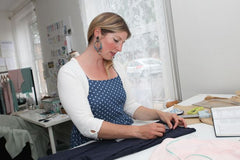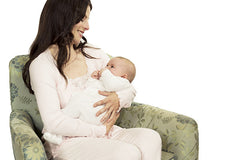-
SHOP Art
- Art Prints
-
Gift Shop
- Artist Blog
- Learn
- My Story
- Contact
- Exhibitions
-
December 19, 2013
Breastfeeding for the first time can be a little daunting despite it being one of those natural things. Whether it's your first born or not, both you and your baby will need to work together to create a good latch and comfortable feeding position. In the early days, this may be more tricky especially if you've had a difficult birth or a cesarian section as it can be uncomfortable to sit or lie in certain positions. There is a lot of advice available for helping you with breastfeeding and you should be able to find that your local midwife, breastfeeding support counsellor or health visitor will be able to help you overcome any issues simply by observing and offering you further tips. Don't be afraid or shy to ask for help as breastfeeding is a learning process – little pearls of wisdom or encouragement passed on from other mums and health professionals could give you the help, confidence and boost you need. A simple piece of advice such as “notice which way your nipples are pointing” can make a big difference to where you position baby for the best latch. Or a top tip like applying a good nipple cream from the start to prevent or ease any discomfort in that first week when you are experimenting with latching on, can save you from unnecessary pain.
Hopefully the following short guide will help you succeed in your breastfeeding journey for as long as you wish it to continue.
The key pieces of advice in creating a good latch are:
Hold baby close to you in a comfortable position with their head and body in a straight line facing you.
Support your baby's head but make sure they can tilt their head back to feed
Ensure your baby's nose or top lip are in line with the nipple
Brush baby's nose with nipple to encourage them to open mouth wide then swiftly bring baby to nipple to latch on.
If the latch doesn't feel comfortable, insert your clean little finger into the side of your baby's mouth to release the latch and retry.
These two pages offer good information, guides and great instructional photos:
http://www.feedgoodfactor.org.uk/how-do-i-breastfeed/step-by-step-guide/ (click on the photos for full info)
http://www.amazingbreastmilk.nhs.uk/how-to-breastfeed/1205/
Signs that your baby is feeding well at the breast:
Baby has a large mouthful of breast not just the nipple
Baby's lower lip is curled back
Baby's nose is usually clear of the breast
Baby's chin usually pressing breast
You can see more areola above the baby's mouth than below
Baby has full rounded cheeks
Baby sucking rhythmically with pauses and swallows
Feeding should be painless
Contented baby who stays on the breast
Six of the most common breastfeeding / nursing positions to try.
Our Pinterest board illustrates the various positions and holds and should be used in conjunction with this guide.
1. The rugby ball hold, football hold, underarm hold or bagpipes:
Sit in an upright position and lie your baby alongside you, tucking them under your arm facing towards you. Their feet may be touching the chair back or wall behind you. If needed, place a pillow under your baby to raise them in line with the breast. Tuck your arm around them, keeping them rolled towards you. Be sure that the baby does not drag on the breast – if you find that they are, try sitting in a more upright forward position, reposition the support under baby and possibly even swing baby's bottom away from you a little. This position works really well if you've had a c section or if you need to correct any latching-on issues as it gives you a clear view of your baby.
This is also a fantastic position for breastfeeding twins as they can both gain access to a breast each without bumping into each other.
2. & 3. The cradle hold and cross cradle hold:
This is by far one of the best starter positions as it allows you to really see your baby, check their latch and watch them feed. Make sure you are sitting comfortably – you may wish to have a small pillow tucked into the small of your back or a larger pillow supporting your elbow on the side you are about to feed from. Lie the baby across your body, baby facing you, supporting their head in the crook of your arm from the side you're about to feed from.
Alternatively for the cross cradle position, place a pillow on your lap to lie your baby on facing you and simply rest baby's head on the pillow. Use the same hand as the breast you're are feeding from to move or support your breast whilst your other arm supports baby. This is often a good position whilst baby learns to latch and also works well for mums with larger breasts.
4. Lying down position
Lie down on your side in a foetal position, legs drawn up. Place a cushion behind your back for support if necessary to prevent you rolling onto your back. Support your neck sufficiently with pillows. Raise your lower arm (the one you're laid on) ninety degrees in line with your shoulder. Lie your baby alongside you on their side facing you. Raise their feet into the nook of your legs, up against your hips or lie them straight. Their head should be up near your armpit and their nose level with your nipple. You can hold them close to you with your free upper arm or tuck a small firm cushion into the small of their back to prevent them rolling away from you. This is the most helpful position if you've had a difficult birth or a c-section and can be great for night feeds and those of you co-sleeping. Of course you should always take steps to ensure baby will not be smothered or covered if you both fall asleep in this position.
5. The saddle position, upright or koala hold
This position works well for older babies who can support their own heads and wish to a have a better view of their surroundings as they nurse. Simply sit in any upright position with them sat on your hip legs tucked around you like a koala or straddling your leg facing the breast, in a tummy to tummy cuddle position. Sit baby on a pillow or rolled up jumper if they need to be raised higher to the breast so their nose is in line with your nipple.
6. Laid back position
Prop yourself up on your pillows in bed or raise the back of your maternity hospital bed into a slightly more upright position. Alternatively slide down into a comfortable reclining position in your armchair. Lay baby tummy to tummy on top of you ensuring baby's nose is level with your nipple. This is a good position for the first skin to skin feed post birth or afterwards when you're tired or have had a c-section. Do make sure your own lower back is supported.
Breastfeeding postions or nursing hold for tandem feeding twins:
Tandem feeding twins sounds tricky but by all accounts, can be mastered quickly. Two of the most common breastfeeding positions for tandem feeding twins is the rugby ball hold or laid back position so that you can feed both babies at once although a combination of positions may be more suitable for you. You may find that placing one in a cradle position with the other twin tucked in behind them in the rugby ball position suits you just as well. Twins are used to being close so don't worry too much about heads, bums, limbs crossing over each other – just find a position that suits you all! We've included some pins on our Pinterest boards specifically illustrating tandem feeding positions.
Ultimately, as long as you are comfortable, baby is latching on well and breastfeeding is not painful, then whichever position you adopt is a good one! Just to illustrate this point, we've included a Japanese nursing chart on our Pinterest board for many weird and wonderful positions to feed your baby wherever, however! Unfortunately we have no idea what the text translates as so we hope it's not offensive.
What to wear:
In the same way you would choose wellies for going out in the rain or a swimsuit for swimming, do consider what to wear whilst breastfeeding. You can simply wear a stretchy vest and pull it down under your breast to feed but bear in mind that nursing bras and nursing tops / breastfeeding clothes are designed for the exact purpose of breastfeeding – making it easier for you and baby to just get on with the task at hand without hinderance.
A well fitting nursing bra should be supportive and not dig in or cause discomfort on the breast as this can lead to blocked ducts and infections such as mastitis. Your breast size will fluctuate according to baby's milk demand and your body shape will adjust post birth so you will need to be remeasured regularly for new bras throughout your breastfeeding journey.
Our Charlotte Keating ENGLAND nursing clothes have been designed to help you nurse with ease and discretion whilst remaining flattering as your body fluctuates pre and post birth. Our designs have single handed pull-up or pull-aside openings for easy and discreet access providing complete modesty when breastfeeding. The discreet feeding panel is cut in just the right shape and place to ensure easy and ample access for your baby. All our breastfeeding clothes are made from soft, supple, viscose jersey (a natural, comfortable and breathable material similar to cotton) with 8% elastane content so that our clothes bounce back to their original shape after manipulation when feeding. Our nursing tops are cut to fit and flatter a post natal body with a fuller bust and more generous cut around the hips and tummy. Double thickness on the bust area disguises breast-pad silhouettes. All these features are included in our well thought through design so you can wear our nursingwear range with complete confidence knowing they are designed by one experienced mum for all new mums.
Disclaimer: we are not health professionals or experts in this area. This guide has been produced as a small self help guide and we encourage you to seek medical and breastfeeding advice from your midwife, health visitor, health professional or breastfeeding support counsellor.
September 26, 2017

August 31, 2017
We're starting a campaign which aims to inspire & empower more women to breastfeed with confidence! Supported by a monthly GIVEAWAY and Breastfeeding Cards, we want to encourage more mums to #BreastfeedWithEase #NurseInStyle
July 21, 2017

Are nursing tops important? We discuss the benefits and best buys for mums expecting to breastfeed. Nursingwear to help mums breastfeed confidently.
